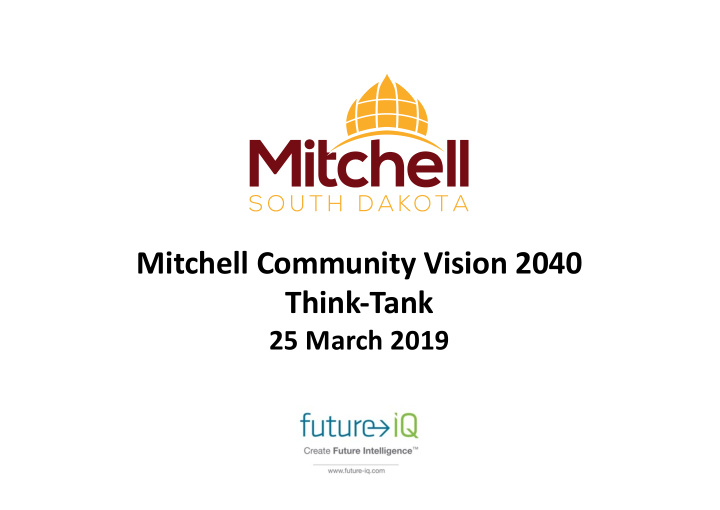



Mitchell Community Vision 2040 Think-Tank 25 March 2019
Future iQ Project Team Heather Branigin Celine Beurle David Beurle Vice President, COO & Managing Founder and CEO Jim Director, Future iQ Europe Foresight Research Haguewood, Economic Additional Team Members: Tobiloba Adaramati Development Walter Paixao-Cortes Specialist
The challenge for today… Explore the future Ask the hard questions Think creatively The outcome will be a new view of the future and consideration of the implications for the future of the City of Mitchell.
Fo Forces impa pacti ting the the world rld (and nd re regio ions ns) Wh What are the em emer ergi ging m g mac acro o dr driver ers… s…
Macro Trends and Forces of Change Related to . . . • Demographics, population and mass urbanization • Changing macro economics and societal values • Energy, food, water & changing climate • Technology, and the next industrial revolution
Demographics, population and mass urbanization
Median age in selected countries
Demographics, Population, Mass Urbanization • Increasing global population • People are living longer • Global surge in younger cohorts • Greater urbanization and mega cities • Society is reconfiguring around urban hubs
Demographics, population and mass urbanization What does this mean for Mitchell?
Macro-economics, shifting power and changing societal values
Animal Proteins – the Pressure Point? Around 99% of all meat in the US comes from factory farms . We're addicted to meat. And it's destroying the planet. World Economic Forum 26 Sept 2016
Macro-economics and changing societal values • Uneven global growth – growth and deflation uneven. • US global role is changing • Global financial and political architecture is changing • Changing societal values
Macro-economics and changing societal values What does this mean for Mitchell?
Energy + Water + Climate Change + Food
En Ener ergy gy • At At pr pres esen ent 2.5 5 billion pe peopl ple rely y on burning wo wood and animal dung as th as their r chief sourc rce of en ener ergy • 1. 1.5 billion pe peopl ple have no el elect ectrici city of f any ki kind. International Energy Agency's "World Energy Outlook 2009" report
Ren Renewa ewable e Ener ergy gy
• Near Nearly 4 450 m 50 million on p peop eople i e in 2 29 9 co countries now w face ce severe wa water r sho hort rtages • As As much uch as 2/3 2/3 of the he wo world rld po popu pulati tion could be be wate ter- st stressed b essed by 2 202 025 • Ha Half th the wor orld’s ’s rivers and la lake kes are re serio rious usly ly pollute lluted World Hunger 2007
• Ir Irrig igatio ion uses 70% of the wo world’s fr fresh wa water • Wa Water scarcity, not ot lack of of ar arab able land and, will be the he chi hief co constra raint t to i incre creased f food produc pr uction • Th The threat to o water resou ources st stands s as s one of the major cri crises f faci cing t the p planet World Hunger 2007 Mid Midwest has 20% of glo lobal l fre fresh water r re resourc rces
Food Demand The relative growth of staple grains required by 2050 is approximately 46%, while animal protein growth is 76% Rural Industries Research and Development Corporation (RIRDC) report, Rural Industry Futures: megatrends impacting Australian agriculture over the coming twenty years.
Energy + Water + Climate Change + Food • Challenges with finite resource base • Uneven impacts of climate change • Potential for unexpected trends • Disconnect between where food can be grown, and where it will be consumed
Energy + Water + Food + Changing Climate What does this mean for Mitchell?
Technology + Next Industrial Revolution
Technology – a catalyst for change
An An analysi sis s of the hist story of tec technology shows th that t tec technological ch change i is e exp xponential, Im Imagin ine the la last 100 years of tec technological change e and th the e im impacts on our liv lives. Th The next 100 00 years of of prog ogress in in the 21st century……… wi will be more like 20,000 ye year ars of pr progress (a (at today’s rate)
Additive – allowing incredible complexity in design and material composition
Complexity and prototyping
What makes this industrial revolution different? • Machine learning / Artificial Intelligence • Converging technologies • Exponential impacts
Industrial ‘Internet of things’ ’ By 2020 – between 25 and 100 billion things will be connected to the internet
Adapted from: Source: Deloitte. 2014. Industry 4.0 Challenges and solutions for the digital transformation and use of exponential technologies
Technology + Next Industrial Revolution • Impacting every corner of our lives • Capacity to radically disrupt systems • Changes in where things will be made • New materials and new products
Technology - driving and enabling accelerated change What does this mean for Mitchell?
What internal trends are happening (or are emerging) that could be game-changers for the future of Mitchell?
Thank you! For up-to-date information on the Mitchell Community Vision 2040 project, please visit: http://lab.future-iq.com/city-of-mitchell- community-visioning-project/
Recommend
More recommend